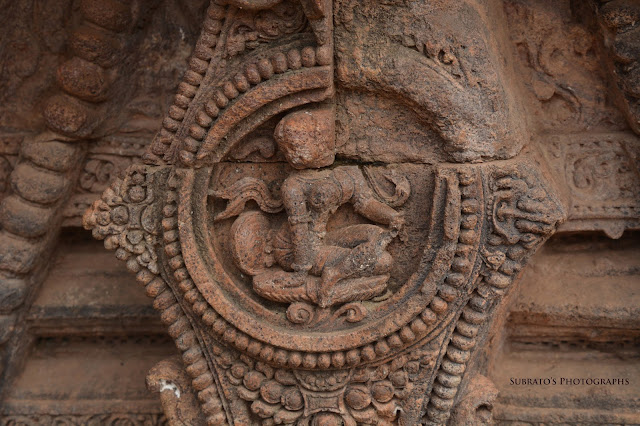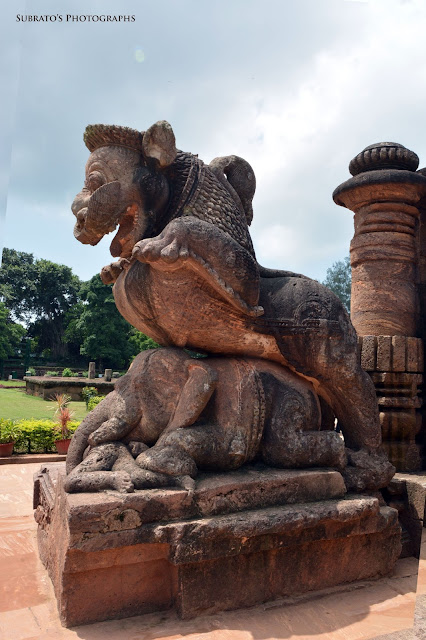Enigmatic Konark : A Pictorial Tribute
‘‘Those
who are critical and difficult to please, they stand astonished at this
sight,’’ wrote Abul Fazal, the famous court historian of King Akbar—in
‘Ain-i-Akbari’ about the magnificance of Konark’s Sun Temple. He also described
that the temple was built during the reign of King Narasimha I (1238-1264 AD). The account also mentions that 12000 artisans built the temple at the cost of 12 years of revenue.
Today this magnificent replica of Sun God’s chariot is in a bad shape, deteriorating daily, unable to resist the devastating rigors of time. It is an unfortunate fact that Konark is a victim of nature’s cruelty. Continuous stone erosion and weathering have already taken a toll and blunted the fineness of the delicately carved figurines. Soft stone is deteriorating fast due to salt action, wind, humidity, rain-water, algae and fungal growth. Whatever remains, remains is a very precarious state.
My first introduction to Konark was through playwright Jagdish Chandra Mathur’s Hindi play ‘Konark’ which was in our syllabi. Since then I was longing to visit the historic temple. My dream became a reality only after more than 40 years.
Standing there, under cloudy skies, the beauty and grandeur of the Sun Temple of Konark left me awed and curious. It looks spellbinding. The thoughts about the missing links in temple’s life cycle automatically cropped up . . . like an impossible jigsaw puzzle, the history of Konark is shrouded in mystery. Starting from its construction, consecration to collapse, legends and theories abound. Truth is no historian, archaeologist, researcher can claim with certainty the real story behind this world famous edifice.
Many stupendous and magnificent temples were built in Odisha between 7th to 13th century and many of them can be seen at Puri, Bhuvneshwar and other places. Temples built much before Konark are in better condition. Strangely no big temple was built in Odisha after Konark. Somehow all artisans too went missing or all royal patronage suddenly ceased.
Here, I do not wish to discuss about the construction, history or destruction of this awesome structure as a large amount of information is already available. Pt. Sada Shiv Rathsharma—the first Oriya honoured with a ‘Padmashree’—has excavated many of the theories surrounding Konark in his book titled ‘Sun Temple of Konark’.
Today the reconstructed remains of this UNESCO World Heritage structure stands on a sprawling 12-acre patch close to the Bay of Bengal. Konark is, undisputedly, an example of elegance and beauty. The heightened level of creativity, the intricate carvings, the erotic scenes telling tales of creation and procreation and its architectural magnificence is a source of joy and sadness simultaneously.
According to experts, the entire structure, resembling a colossal chariot with 12 pairs of wheels (actually sundials which can be used to calculate time accurately), lavishly sculpted with symbolic motifs and pulled by seven horses, was so designed to let the first rays of the sun fall on the main entrance. What a wonderful design it would have been. When poet Rabindranath Tagore described it as ‘‘Here the language of stone surpasses the language of man,’’ how correct he was!
Today this magnificent replica of Sun God’s chariot is in a bad shape, deteriorating daily, unable to resist the devastating rigors of time. It is an unfortunate fact that Konark is a victim of nature’s cruelty. Continuous stone erosion and weathering have already taken a toll and blunted the fineness of the delicately carved figurines. Soft stone is deteriorating fast due to salt action, wind, humidity, rain-water, algae and fungal growth. Whatever remains, remains is a very precarious state.
My first introduction to Konark was through playwright Jagdish Chandra Mathur’s Hindi play ‘Konark’ which was in our syllabi. Since then I was longing to visit the historic temple. My dream became a reality only after more than 40 years.
Standing there, under cloudy skies, the beauty and grandeur of the Sun Temple of Konark left me awed and curious. It looks spellbinding. The thoughts about the missing links in temple’s life cycle automatically cropped up . . . like an impossible jigsaw puzzle, the history of Konark is shrouded in mystery. Starting from its construction, consecration to collapse, legends and theories abound. Truth is no historian, archaeologist, researcher can claim with certainty the real story behind this world famous edifice.
Many stupendous and magnificent temples were built in Odisha between 7th to 13th century and many of them can be seen at Puri, Bhuvneshwar and other places. Temples built much before Konark are in better condition. Strangely no big temple was built in Odisha after Konark. Somehow all artisans too went missing or all royal patronage suddenly ceased.
Here, I do not wish to discuss about the construction, history or destruction of this awesome structure as a large amount of information is already available. Pt. Sada Shiv Rathsharma—the first Oriya honoured with a ‘Padmashree’—has excavated many of the theories surrounding Konark in his book titled ‘Sun Temple of Konark’.
Today the reconstructed remains of this UNESCO World Heritage structure stands on a sprawling 12-acre patch close to the Bay of Bengal. Konark is, undisputedly, an example of elegance and beauty. The heightened level of creativity, the intricate carvings, the erotic scenes telling tales of creation and procreation and its architectural magnificence is a source of joy and sadness simultaneously.
According to experts, the entire structure, resembling a colossal chariot with 12 pairs of wheels (actually sundials which can be used to calculate time accurately), lavishly sculpted with symbolic motifs and pulled by seven horses, was so designed to let the first rays of the sun fall on the main entrance. What a wonderful design it would have been. When poet Rabindranath Tagore described it as ‘‘Here the language of stone surpasses the language of man,’’ how correct he was!
Standing there, I
remembered few lines of renowned Odisha poet Jayanta Mahapatra’s poem ‘Konaraka’:
‘‘Konaraka, black is sleep cold become of
my silent land
messenger
of death.
Here the little boy in a dream waved to the
Man once and
death
hung its peace;
An indifferent time of stone marks the
brunt-out funeral and
The sunrise that journeys again and again
to call
this
grief of man its own.’’
× × ×
‘‘I
must carry the stone I found in the late afternoon light
Me
not think of myself only,
And my pain which possesses
And my pain which possesses
These
last breaths of my life.’’
One visit, few hours are not enough to appreciate or soak the essence of majestic Konark. Promise to visit again.
One visit, few hours are not enough to appreciate or soak the essence of majestic Konark. Promise to visit again.
Useful
links:
http://www.outlookindia.com/magazine/story/eclipse-over-konark/206424
https://www.youtube.com/watch?v=pbxpYkobawY
https://www.youtube.com/watch?v=pbxpYkobawY



























Comments
it was built so many years ago....how rich and glorious this state was....leaves us pondering ...how poor we are in now--albeit the advancements...modern structures look crude and un elegant when placed against such creative and artistic brilliance
कोणार्क में खड़ी
यही सोचती रही
यहाँ इतनी सारी स्त्रियाँ क्यों
और वह भी खुले में इतनी रोशनी और तपिश के बीच में !
यह एक ख़ास कोण है
पहली किरण को सीधे गर्भस्थल तक ले जाने वाला कोण।
और, स्त्रियाँ नाचने लगतीं
गाने लगतीं, उन्मत्त प्रेम करतीं
काम के हर सुख को भोगती
युद्ध के मैदान से लेकर घर गृहस्थी तक
हर मोर्चे पर डटी रहतीं
पूरे संसार पर राज करतीं।
मन में सवाल उठता है
स्त्री स्वातंत्र्य या स्त्री लीला !
कोणार्क तो इसी लीला की कथा है
गान है जीवन का, स्त्री की मनुष्यता का।
हे कोणार्क
तुम जिस प्यार की प्यास हो
वही सचमुच आज हमारे दर्द की आवाज है
शायद इसीलिये
तुम्हारे गर्भ पर किसी देवता का शासन नहीं हुआ
तुम तो स्त्रियों का सरताज हो ।
लौटते वक़्त ट्रेन में बेहद ख़फ़ा था एक भक्त
कोरा खंडहर है
न कोई देवी, न कोई देवता
ऊपर से इतनी कड़ी धूप
क्यों बेकार इसे मिलता है इतना प्रचार !
कोणार्क
तुम पुरुष की कसौटी हो
इसीलिये तुम बेहद प्रिय हो!